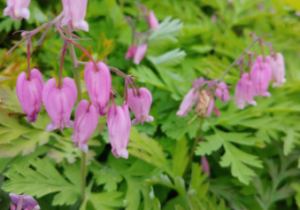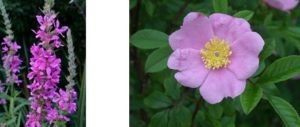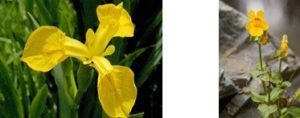Landscaping with Native Plants
 Memorial Day weekend is upon us and many people are making new plans for their yard and garden spaces. In this post, we’ll offer some tips about the plants you may find in your yard, using information from Washington Native Plant Society and the King County Noxious Weed Control Program.
Memorial Day weekend is upon us and many people are making new plans for their yard and garden spaces. In this post, we’ll offer some tips about the plants you may find in your yard, using information from Washington Native Plant Society and the King County Noxious Weed Control Program.
Many of the below plants were once widely used for ornamental purposes and have since been placed on statewide quarantine lists that make them illegal to buy and sell. However, their continued presence in the landscape – even on private property — can have a detrimental effect on the surrounding plant and animal communities. Invasive weeds in your yard can spread to parks and local natural areas, eventually taking over the native vegetation. In undisturbed ecosystems, plants that are native to the region have evolved and adapted to thrive in the conditions of that ecosystem. Invasive plants often reproduce and grow quickly, outcompeting the native plants which support healthy wildlife populations. Ecosystems which are dominated by invasive species are also worse at supporting wildlife and filtering out pollutants from air and water, and can cause harmful shifts in a landscape’s natural fire regime.
To help curb the spread of invasive plants in backyard landscapes or gardens, consult this list of 10 common invasive plants found in gardens and native plant alternatives that can be used in their place.
10 Invasive Landscape Plants & their Substitutes
1.Policeman’s Helmet (left) substitute with Bleeding Heart (right)
This weed was introduced to the Pacific Northwest as an ornamental plant. It has since escaped into moist riparian areas such as stream sides or lowland forests. To halt its spread, try planting the native bleeding heart instead. Its gorgeous, heart-shaped flowers are an easy way to beautify any outdoor space.
2. English Ivy (left) substitute with Orange Honeysuckle (right)
English ivy is commonly used as a climbing vine in gardens and on houses. Since this evergreen plant is well-adapted to a mild maritime climate, it thrives in the Pacific Northwest and outcompetes native shrubs and trees quickly. Instead of ivy, consider using orange honeysuckle, a native vine that sports beautiful orange flowers and can climb up to 20 feet.
3. Butterfly Bush (left) substitute with Douglas Spiraea (right)
Contrary to what its name suggests, butterfly bush is actually detrimental to native pollinators such as bees and butterflies. Though pollinators do love its bright purple flowers, butterfly bush tends to crowd out native vegetation, leaving less plant biodiversity to sustain pollinator populations throughout the entire growing season. To plant properly for pollinators, it’s best to ensure that at least two or three different plant species are blooming at any given time from April to September. Try spiraea instead: it has a similar aesthetic look with pretty clustered flowers and can support healthier pollinator populations.
4. Purple Loosestrife (left) substitute with Cluster Rose (right)
Purple loosestrife grows well in wetland areas, particularly along stream banks and reservoirs, and easily clogs waterways and irrigation channels. Cluster rose , also known as swamp rose, prefers wet soil conditions as well, but does not outcompete other native plants, leaving a more diverse plant community.
5. Yellow Flag Iris (left) substitute with Yellow Monkeyflower (right)
Yellow flag iris is a highly invasive ornamental flower that grows well in shallow water and has the potential to irritate human skin. For a similar flower that won’t spread out of control, try planting yellow monkeyflower instead. Yellow monkeyflower grows well in moist soils and can flourish as an aquatic plant completely submerged in water.
6. Tansy Ragwort (left) substitute with Golden Eyed Grass (right)
Similar to yellow flag iris, tansy ragwort is extremely toxic to livestock. However, this plant grows commonly in open meadows, fields, cleared forests and alongside roads, and can spread to backyards easily. Golden eyed grass is a great native substitute, as it thrives in sunny conditions and well-drained soils.
7. Scotch Broom (left) substitute with Tall Oregon Grape (right)
Scotch broom colonizes disturbed areas quickly, much like yellow flag iris. A great alternative to scotch broom is Oregon grape: it also has bright yellow flowers which bloom in early Spring, which can add lots of color to your garden.
8. Japanese Knotweed (left) substitute with Thimbleberry (right)
Knotweed is a very aggressive ornamental that is quarantined in Washington, but widely established. New plants can easily propagate from rhizomes and small plant material left after removing the original plant, so extreme care must be taken when attempting to eradicate clumps of knotweed. Thimbleberry has similar large foliage to knotweed without the detrimental effects of outcompeting native vegetation and degrading wildlife habitat. It even produces delicious, edible red berries in midsummer!
9. Yellow Archangel (left) substitute with Wild Strawberry (right)
This small, flowering groundcover plant spreads rapidly and can easily outcompete native understory vegetation. A similar low-growing plant native to Washington is the wild strawberry: it begins blooming in early spring, but has the added benefit of producing tasty fruits all summer long.
10. Black Locust (left) substitute with Pacific Dogwood (right)
The black locust tree can grow quickly in the Pacific Northwest and form dense stands that are difficult to manage, mostly due to its ability to fix atmospheric nitrogen to enhance its growth. It prefers moist soils and produces white flowers. Pacific dogwood also grows well in moist soils and can sport beautiful pink or white flowers, making it a suitable alternative to the black locust tree.
By planting natives in your yard or garden, you can help slow the spread of invasive weeds and contribute to a healthier, more diverse ecosystem. Whether you choose to actively plant natives instead of invasives or clear any noxious weeds growing in your backyard, your actions can benefit our local environment. For more alternatives to invasive plants, check out this list by the Washington State Noxious Weed Control Board. You can also consult this article by the Washington Native Plant Society for more information about gardening with native plants. Additionally, if you’re interested in learning more about how to plant for pollinators, look into this comprehensive guide by Earth Corps or this article by The Xerxes Society. Finally, if you need assistance identifying invasive weeds or want to report a weed infestation, visit this guide by King County.
Written by Christina Bjarvin, DNDA Environmental Outreach Specialist










